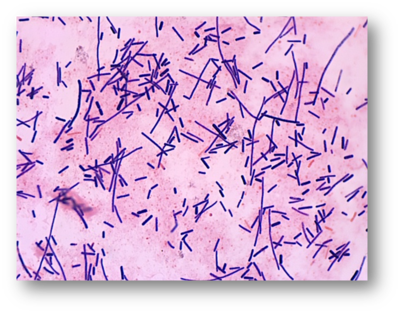Clostridium baratii: Difference between revisions
No edit summary |
No edit summary |
||
| Line 1: | Line 1: | ||
[[Image:C.baratii.png|400px|thumb|right|''C. baratii'' on EG agar | {{Uncurated}} | ||
[[Image:C.baratii.png|400px|thumb|right|''C. baratii'' on EG agar. http://www.jcm.riken.jp/cgi-bin/jcm/jcm_keyword?AN=Clostridium&BN=barati&CN=&DN=]] | |||
==Classification== | ==Classification== | ||
Revision as of 05:03, 4 April 2017

Classification
Higher order taxa
Bacteria; Firmicutes; Clostridia; Clostridiales; clostridiaceae [Others may be used. Use NCBI link to find]
Species
|
Clostridium Baratii NCBI: [1] |
Clostridium baratii
Description and significance
Clostridium baratii derives its name from the French bacteriologist Barat. This species of bacteria was first identified in 1938 by Prévot. C. baratii are gram positive rod-shaped bacteria, the colonies of which can appear round or irregular and have a diameter of 2mm or smaller. C. baratii do not typically appear in groups and are nonmotile. This species can produce spores which are round or oval and located at or near the terminus of the cell(1).
C. baratii produces toxins which cause botulism, most notably in infants (2, 3).
Clostridium genus: [[2]].
Genome and genetics
The genus Clostridium is part of the prokaryotic branch Firmicutes (1). C. baratii is part of Cluster I of the Clostridium' genus and is most closely related to the species Clostridium sardiniense according to the phylogenic tree (Collin et al., as cited in 1). C. baratii is also closely related to several species of Eubacteria, particularly Eubacterium budayi, with which it shares 99.5 percent of its genome according to 16S rRNA genetic sequencing (1).
The genome of C. baratii shows 28 percent G+C content (1) and the genome of C. baratii strain XCM is 3083960 base pairs in length (4). This strain of C. baratii has 3027 genes, 2920 of which code for various proteins (4).
Nutrition and metabolism
C. baratii is an anaerobic bacteria species (1). Through fermentation of glucose in PYG broth, C. baratii can produce lactic acid, acetic acid, and butyric acid, as well as the potentially volatile product hydrogen gas (1). This bacteria also produces ammonia in deep agar cultures (1). Additionally, C. baratii converts pyruvate to acetate and butyrate but does not utilize lactate (1).
C. baratii is grown in the laboratory in Peptone Yeast Glucose broth and on blood agar plates and produces the most abundant growth at temperatures between 30 and 35 degrees Celsius (1). It requires salinity below 6.5 percent sodium chloride (1). C. baratii grows in PYG broth, which has a nearly neutral pH, but over several days of culture growth the pH lowers to between 4.5 and 4.8 (1, catalog).
C. baratii reduces the indicator dyes neutral red and resazurin (1).
Pathology
Pathology: How does the microbe cause disease as it interacts with the host? Describe any specific toxins or pathways that are used for invading and causing disease in the host. What treatment is used to inhibit or kill the microbe?
Current Research
Describe recent research and findings that have been done with this organism. The research can be clinical, applied or basic research. This section should be based on 2 recent papers (10 years or less) and summarized in your own words.
References
[1] De Vos P, Garrity GM, Jones D, Krieg NR, Ludwig W, Rainey FA, Schleifer KH, Whitman WB, editors. Bergey’s manual of systematic bacteriology (2nd ed., vol 3). Dordrecht: Springer; 2009. p. 756-757.
[2] Shirey TB, Dykes JK, Lúquez C, Maslanka SE, Raphael BH. Characterizing the fecal microbiota of infants with botulism. Microbiome [Internet]. 2015 [cited 12 Feb 2017];3(54). Available from https://www.ncbi.nlm.nih.gov/pubmed/26593441
[3] Tréhard H, Poujol I, Mazuet C, Blanc Q, Gillet Y, Rossignol F, Popoff M, Jourdan Da Silva N. A cluster of three cases of botulism due to Clostridium baratii Type F, France, August 2015. Eurosurveillance [Internet]. 2016 [cited 13 Feb 2017];21(4). Available from http://www.eurosurveillance.org/ViewArticle.aspx?ArticleId=21360
[4] Joint Genome Institute. Clostridium baratii XCM [Internet]. 2016 [cited 3 Apr 2017]. Available from https://img.jgi.doe.gov/cgi-bin/m/main.cgi?section=TaxonDetail&page=taxonDetail&taxon_oid=2648501875#browse
[5] Thavaselvam D, Vijayaraghavan R. Biological warfare agents. Journal of Pharmacy and Bioallied Sciences [Internet]. 2010 [cited 3 Apr 2017];2(3). Available from https://www.ncbi.nlm.nih.gov/pmc/articles/PMC3148622/
Authored by Emma Wingert, a student of CJ Funk at John Brown University
